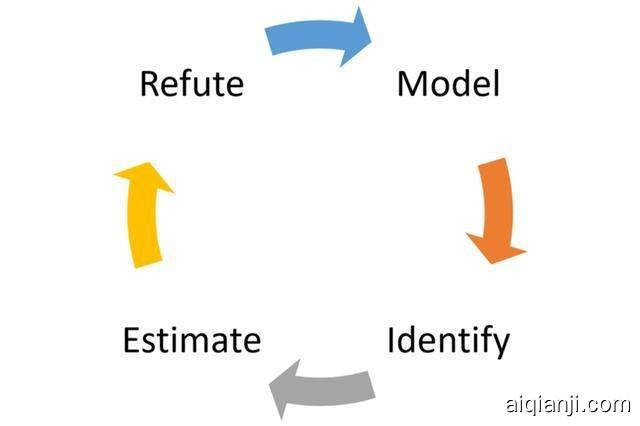DoWhy通过四个基本步骤对工作流中的任何因果推断问题进行建模:模型,识别,估计和反驳。

建模: DoWhy使用因果关系图来模拟每个问题。当前版本的DoWhy支持两种图形输入格式:gml(首选)和点。该图可能包括变量中因果关系的先验知识,但DoWhy没有做出任何直接的假设。
识别:使用输入图,DoWhy根据图形模型找到识别所需因果效果的所有可能方法。它使用基于图形的标准和do-calculus来找到可以找到可以识别因果效应的表达式的潜在方法
估计: DoWhy使用统计方法(如匹配或工具变量)估算因果效应。当前版本的DoWhy支持基于倾向的分层或倾向得分匹配的估计方法,这些方法侧重于估计治疗分配以及侧重于估计响应面的回归技术。
验证:最后,DoWhy使用不同的稳健性方法来验证因果效应的有效性。
Confounding Example: Finding causal effects from observed data
Suppose you are given some data with treatment and outcome. Can you determine whether the treatment causes the outcome, or the correlation is purely due to another common cause?
假设给你一些关于治疗和结果的数据。你能确定是治疗导致了结果,还是相关性纯粹是由于另一个共同的原因?
[1]:
import os, sys
sys.path.append(os.path.abspath("../../"))
[2]:
import numpy as np
import pandas as pd
import matplotlib.pyplot as plt
import seaborn as sns
import math
import dowhy
from dowhy import CausalModel
import dowhy.datasets, dowhy.plotter
Let’s create a mystery dataset for which we need to determine whether there is a causal effect. 让我们创建一个神秘的数据集,我们需要确定是否存在因果效应
Creating the dataset. It is generated from either one of two models: * Model 1: Treatment does cause outcome. * Model 2: Treatment does not cause outcome. All observed correlation is due to a common cause.
创建数据集。它产生于两种模式之一:
模式1: 治疗确实导致结果。
模式2 : 治疗不会导致结果。所有观察到的相关性都是由于一个其他共同的原因。
[3]:
rvar = 1 if np.random.uniform() >0.5 else 0
data_dict = dowhy.datasets.xy_dataset(10000, effect=rvar, sd_error=0.2)
df = data_dict['df']
print(df[["Treatment", "Outcome", "w0"]].head())
Treatment Outcome w0 0 7.598026 15.812081 2.011138 1 7.601832 15.305892 1.841549 2 10.137274 19.918058 3.977756 3 9.444259 19.138840 3.790387 4 2.708849 5.403166 -3.191784
df数据如下
Treatment Outcome w0 s
0 1.869872 3.832871 -3.984799 7.123291
1 2.790359 5.671909 -3.065245 7.966827
2 2.889123 5.148204 -3.277346 7.850091
3 8.908309 17.343314 2.623172 4.173383
4 6.467875 13.052497 0.390332 9.095312
[4]:
dowhy.plotter.plot_treatment_outcome(df[data_dict["treatment_name"]], df[data_dict["outcome_name"]],
df[data_dict["time_val"]])

Using DoWhy to resolve the mystery: Does Treatment cause Outcome? 使用 DoWhy 来解开谜团:治疗会有效吗?
STEP 1: Model the problem as a causal graph 步骤1: 将问题建模为因果关系图
Initializing the causal model.
初始化因果模型。
[5]:
model= CausalModel(
data=df,
treatment=data_dict["treatment_name"],
outcome=data_dict["outcome_name"],
common_causes=data_dict["common_causes_names"],
instruments=data_dict["instrument_names"])
model.view_model(layout="dot")
WARNING:dowhy.causal_model:Causal Graph not provided. DoWhy will construct a graph based on data inputs. INFO:dowhy.causal_model:Model to find the causal effect of treatment ['Treatment'] on outcome ['Outcome']
Showing the causal model stored in the local file “causal_model.png”
显示存储在本地文件“causal_model. png”中的因果模型
[6]:
from IPython.display import Image, display
display(Image(filename="causal_model.png"))

STEP 2: Identify causal effect using properties of the formal causal graph 步骤2: 使用形式因果图的属性识别因果效应
Identify the causal effect using properties of the causal graph. 使用因果图的属性来识别因果效应。
[7]:
identified_estimand = model.identify_effect()
print(identified_estimand)
INFO:dowhy.causal_identifier:Common causes of treatment and outcome:['w0', 'U'] WARNING:dowhy.causal_identifier:There are unobserved common causes. Causal effect cannot be identified.
WARN: Do you want to continue by ignoring these unobserved confounders? [y/n] y
INFO:dowhy.causal_identifier:Instrumental variables for treatment and outcome:[]
Estimand type: ate
### Estimand : 1
Estimand name: iv
No such variable found!
### Estimand : 2
Estimand name: backdoor
Estimand expression:
d
──────────(Expectation(Outcome|w0))
dTreatment
Estimand assumption 1, Unconfoundedness: If U→Treatment and U→Outcome then P(Outcome|Treatment,w0,U) = P(Outcome|Treatment,w0)
STEP 3: Estimate the causal effect 步骤3: 估计因果效应
Once we have identified the estimand, we can use any statistical method to estimate the causal effect.
一旦我们确定了估计值,我们就可以使用任何统计方法来估计因果效应。
Let’s use Linear Regression for simplicity.
为了简单起见,让我们使用线性回归。
[8]:
estimate = model.estimate_effect(identified_estimand,
method_name="backdoor.linear_regression")
print("Causal Estimate is " + str(estimate.value))
# Plot Slope of line between treamtent and outcome =causal effect
dowhy.plotter.plot_causal_effect(estimate, df[data_dict["treatment_name"]], df[data_dict["outcome_name"]])
INFO:dowhy.causal_estimator:INFO: Using Linear Regression Estimator INFO:dowhy.causal_estimator:b: Outcome~Treatment+w0
Causal Estimate is 1.0099765763913107

Checking if the estimate is correct 检查估计是否正确
[9]:
print("DoWhy estimate is " + str(estimate.value))
print ("Actual true causal effect was {0}".format(rvar))
DoWhy estimate is 1.0099765763913107 Actual true causal effect was 1
Step 4: Refuting the estimate 第四步: 反驳这个估计
We can also refute the estimate to check its robustness to assumptions (aka sensitivity analysis, but on steroids).
我们也可以驳斥这个估计,以检验其对假设的可靠性(又名敏感度分析,但是是类固醇)。
Adding a random common cause variable 添加一个随机的公共原因变量
[10]:
res_random=model.refute_estimate(identified_estimand, estimate, method_name="random_common_cause")
print(res_random)
INFO:dowhy.causal_estimator:INFO: Using Linear Regression Estimator INFO:dowhy.causal_estimator:b: Outcome~Treatment+w0+w_random
Refute: Add a Random Common Cause Estimated effect:(1.0099765763913107,) New effect:(1.009944524944634,)
Replacing treatment with a random (placebo) variable 用随机(安慰剂)变量取代治疗
[11]:
res_placebo=model.refute_estimate(identified_estimand, estimate,
method_name="placebo_treatment_refuter", placebo_type="permute")
print(res_placebo)
INFO:dowhy.causal_estimator:INFO: Using Linear Regression Estimator INFO:dowhy.causal_estimator:b: Outcome~placebo+w0
Refute: Use a Placebo Treatment Estimated effect:(1.0099765763913107,) New effect:(-0.0004315715075086384,)
Removing a random subset of the data 删除数据的随机子集
[12]:
res_subset=model.refute_estimate(identified_estimand, estimate,
method_name="data_subset_refuter", subset_fraction=0.9)
print(res_subset)
INFO:dowhy.causal_estimator:INFO: Using Linear Regression Estimator INFO:dowhy.causal_estimator:b: Outcome~Treatment+w0
Refute: Use a subset of data Estimated effect:(1.0099765763913107,) New effect:(1.007629285793896,)
As you can see, our causal estimator is robust to simple refutations.
正如你所看到的,我们的因果估计对简单的反驳是鲁棒的。
[
